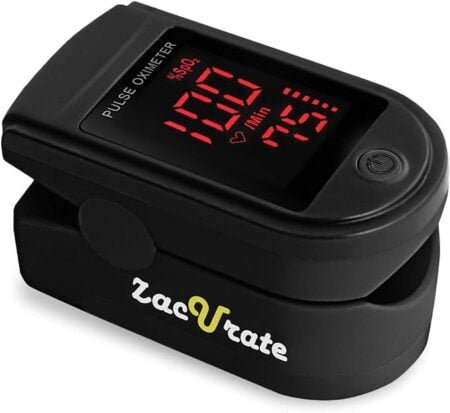
buy product
Introduction to Fingertip Pulse Oximeters
Fingertip pulse oximeters are compact, non-invasive devices primarily designed to measure blood oxygen saturation (SpO2) levels and pulse rate. Their primary function is to provide real-time data on how well oxygen is being transported throughout the body, a critical parameter for assessing respiratory and cardiovascular health. These devices have gained widespread acceptance due to their accuracy, portability, and ease of use.
At the core of a fingertip pulse oximeter is a simple yet effective mechanism that leverages light-emitting diodes (LEDs) and sensors. Typically, a pulse oximeter device comprises two LEDs—one emitting red light and the other infrared light—along with a photodetector. When the device is clipped onto a finger, it emits light that passes through the fingertip. The photodetector measures the amount of light absorbed by the oxygenated and deoxygenated hemoglobin in the blood, allowing the device to calculate the SpO2 levels. This method provides a quick, painless, and reliable way to gauge an individual’s blood oxygen saturation.
The non-invasive nature of fingertip pulse oximeters makes them especially appealing for a variety of applications. In medical settings, they are frequently used for monitoring patients with conditions such as chronic obstructive pulmonary disease (COPD), asthma, and sleep apnea. Home health care providers often rely on these devices to keep tabs on patients’ respiratory status without the need for frequent hospital visits. Furthermore, sports and fitness enthusiasts use fingertip pulse oximeters to optimize their training regimes, ensuring that their oxygen levels remain within a healthy range during intense workouts.
Given their utility, fingertip pulse oximeters have become indispensable tools for maintaining and monitoring health across different contexts. Their versatility and user-friendly design empower individuals and healthcare professionals alike, making the management of health conditions and fitness levels more accessible than ever before.
Benefits and Uses of Pulse Oximeters
Fingertip pulse oximeters offer a range of benefits and practical uses, making them essential tools in both medical and non-medical settings. One of the primary advantages is their ability to provide early detection of respiratory issues. For individuals with conditions such as chronic obstructive pulmonary disease (COPD) and asthma, a pulse oximeter can be invaluable. Regular monitoring of oxygen saturation levels helps in managing these chronic conditions, allowing for timely interventions and adjustments to treatment plans.
These devices have become particularly significant during the COVID-19 pandemic. Monitoring oxygen levels in COVID-19 patients is crucial, as low oxygen saturation can be an early indicator of severe complications, even in the absence of other symptoms. Thus, a fingertip pulse oximeter can aid in making critical, potentially life-saving decisions.
Apart from medical uses, pulse oximeters are beneficial for individuals involved in high-altitude sports or activities, such as mountaineering or aviation. At high altitudes, oxygen levels drop, which can affect physical performance and pose health risks. By providing real-time data on blood oxygen levels, pulse oximeters enable athletes and adventurers to make informed decisions, preventing altitude sickness and other related issues.
Another significant benefit of these devices is the peace of mind they offer. For individuals with underlying health conditions or those recovering from medical procedures, frequent monitoring of oxygen saturation levels can alleviate anxiety. Knowing that a reliable tool is at hand to detect potential drops in oxygen levels provides a sense of security and empowerment.
Overall, fingertip pulse oximeters are versatile, user-friendly devices that support proactive health management. By offering a non-invasive, accurate method to measure blood oxygen saturation, they play a crucial role in both preventive care and active monitoring of various health conditions.
Choosing the Right Pulse Oximeter: Key Features to Consider
When selecting a fingertip pulse oximeter, precision is paramount. Accuracy is the primary feature to consider, as an unreliable reading could lead to misguided health decisions. Look for devices that are FDA-cleared or CE-marked, as these certifications ensure that the device meets essential health and safety standards. Many brands provide data on the margin of error; ideally, choose models with a deviation of no more than ±2% for oxygen saturation levels.
Ease of use significantly impacts the overall user experience. A user-friendly interface is crucial, especially for individuals who may not be tech-savvy. Features such as one-button operation, intuitive design, and clear instructions contribute to simplified usage. Additionally, display readability is essential. Opt for models with large, backlit, high-contrast screens that display results clearly, even in low light conditions.
Battery life also plays a crucial role. Long-lasting batteries—preferably rechargeable ones—enhance the convenience of regular use without frequent replacements. Consider pulse oximeters that feature automatic power-off functions to conserve battery life when not in use.
Portability is another factor to keep in mind. Compact and lightweight designs make it easy to carry the pulse oximeter while on the go. This is particularly beneficial for individuals with active lifestyles or those who need to monitor their oxygen levels frequently.
Some models come equipped with additional functionalities like data storage and smartphone connectivity, offering advanced health monitoring over time. Data storage capabilities allow users to track readings and identify trends, while smartphone connectivity can integrate health metrics with various fitness and health apps for a comprehensive health overview.
To make an informed purchase, compare different brands and models by evaluating user reviews and ratings. Genuine customer feedback can provide invaluable insights into the product’s performance and durability. Ultimately, selecting the best fingertip pulse oximeter involves a balance of accuracy, ease of use, and additional features tailored to your specific needs.
Proper Use and Maintenance of Your Pulse Oximeter
Maintaining and correctly using a fingertip pulse oximeter is essential for accurate and reliable readings of blood oxygen saturation levels. To ensure optimal performance, proper placement on the fingertip is critical. Place the oximeter on your index finger, middle finger, or thumb, ensuring the nail bed is covered entirely by the sensor. Avoid using the device on fingers with nail polish or artificial nails, as these can interfere with the accuracy of the readings.
Several factors can influence the precision of pulse oximeter readings. Poor circulation, caused by conditions such as cold extremities or certain medical conditions, may result in less reliable measurements. To improve circulation, warm your hands before taking a reading. Additionally, consider the environment; bright lights or direct sunlight can affect the sensor’s performance. Opt for a calm and stable environment to reduce external influences.
Once you have obtained your readings, maintenance of the pulse oximeter is crucial. Regularly clean the device with a soft, damp cloth. Avoid using harsh chemicals that could damage the sensor. For devices that require battery power, replace the batteries as needed, typically when the battery indicator shows a low level. Proper storage of the oximeter in a safe, dry place away from extreme temperatures will also help prolong its life and reliability.
Even with proper care, issues may arise. Common problems include inconsistencies in readings or the device not turning on. To troubleshoot, ensure the batteries are correctly inserted and charged. If readings seem erratic, double-check the placement on your fingertip and reposition if necessary. If issues persist, consulting the device’s user manual or reaching out to customer support for further assistance may be beneficial.
By following these guidelines for proper use and maintenance, you can ensure that your pulse oximeter remains a valuable tool for monitoring blood oxygen saturation levels, contributing to better overall health management.
buy product
Discover more from detoatepentrutotisimaimult
Subscribe to get the latest posts sent to your email.
